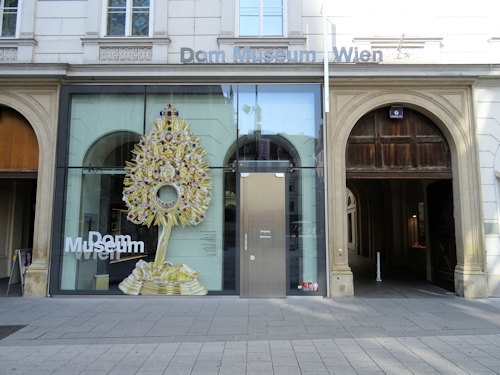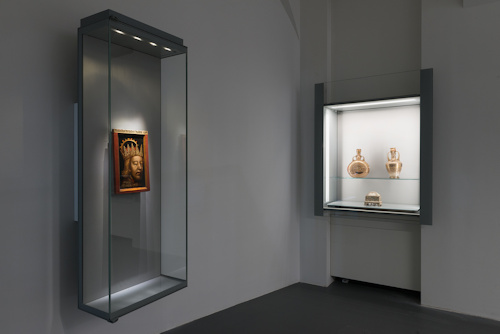You probably don’t think of cathedral museums when you think of abstract and avant-garde art from the 20th-century. The Dom Museum begs to differ.
- Ecclesiastical treasures & modern art
- Some gems in there. For example:
- A 9th-century book
- A Klimt sketch
- Quick to get around and an intriguing mix
- What special exhibition is on?
- Book Dom Museum tickets* online
- …save with the joint cathedral ticket
- See also:
What’s inside?

(The front entrance opposite Stephansdom cathedral)
The Dom Museum forms part of the Archdiocese of Vienna and houses many cathedral and ecclesiastical treasures. It also manages the trick of combining historical riches with art from modern Austria.
So, if you’re thinking dusty shelves with cathedral statues worn down by too many Viennese winters, then think again.
After a three-year renovation, the Dom museum reopened as a bright, airy, and modern exhibition space with three main components:
- The Otto Mauer modern art collection
- The ecclesiastical joys dating back over 1000 years
- Special exhibitions

(Not your usual cathedral-themed museum; press photo courtesy of Dom Museum Wien; photo by Lena Deinhardstein)
Otto Mauer (a priest) was a driving force in promoting modern art and artists in the post-WWII period, running a gallery close to Stephansdom cathedral and accumulating a collection now owned by the Dom Museum.
This remarkable chaplain contributed to, for example, such publications as Profil. The Austrian Monthly Magazine for the Graphic Arts (my translation of the German title).
In the room dedicated to the Mauer collection, you find works by renowned modern Austrian artists, including (on my visit) a black chalk sketch of an old man by none other than Gustav Klimt.
If this priestly interest in art seems unusual to you, be sure to watch the video (which has English subtitles).
The film explains Mauer’s role in re-establishing the ancient link between the church and contemporary art. Not an easy task for him, as you can imagine.
Should you wish to explore that historical link between art and religion in more detail, consider a trip to:
- The initial rooms of the Kunstkammer at the Kunsthistorisches Museum
- The Schottenstift Museum attached to the abbey of the same name (famous for its altar panels)
- The exhibition of masterpieces from the Middle Ages on the ground floor of Upper Belvedere
- Melk and Klosterneuburg abbeys (both outside of Vienna but close enough for an easy day trip)
As well as modern art, modern thinking also creeps into the more traditional cathedral collection in the Dom Museum.
You sense the influence in the organisation under themes like “celebrate” or “follow”. Or in the occasional mix of old and new, like when a 2017 abstract graphite drawing provides the backdrop to a 1630 silver and gold monstrance.

(Exhibition view: The Portrait of Rudolf IV., around 1360, and two Syrian Glass Bottles, around 1280, in the “treasury” of Dom Museum Wien; on loan from St. Stephen’s Cathedral, press photo courtesy of Dom Museum Wien; photo by Lena Deinhardstein)
The ecclesiastical treasures are much as you might expect: chalices, manuscripts, altarpieces, sculptures, paintings, and similar. A silver bishop’s staff from 1515 rubs shoulders with 14th-century wooden figures and 12th-century plaques.
The highlights for me on my visit:
- The 14th-century portrait of Rudolf IV, regarded as a pivotal moment in the history of portraiture (it’s the oldest known portrait featuring a half-frontal view)
- A late 9th-century (!) parchment book. Impressive, though I liked the late 15th-century Vorchentau Missal even more: it looked like a spellbook with its heavy clasps, beautiful script, decorated capitals, floral additions, and gilt decor
- The gilded, enamelled glass bottles from Syria, dating back to around 1300. Gorgeous.
Tickets, exhibitions & tips
The museum has just a handful of rooms, so it doesn’t take long to get around. I was in for an hour and that included taking notes and watching bits and pieces of the videos.
(Booking service provided by Tiqets.com*, who I am an affiliate of)
Special exhibition
The special exhibition typically reflects the museum’s wider approach of mixing the historical with current themes and art, too.
Schedule at the time of writing:
- In the Spirit of Friendship (until August 24th, 2025): an exploration of the concept with the help of various art forms that span the centuries from medieval to contemporary works
A few more tips:
- Consider a combi-ticket* with Stephansdom cathedral, which is opposite the Dom Museum
Cathedral tickets get you access to the bulk of the interior and close to the main altars, let you visit both towers, and include a guided tour of the crypts.
- All items on display are labelled in German and English. You can also pick up a free English booklet with extensive details on collection highlights
- The lockers, ticket counter and exhibitions are on different levels, but a lift ensures no accessibility issues
- A small shop around the ticket counter sells the usual souvenirs (postcards, fridge magnets, pencils, notebooks etc.), including some that nicely mimic the coloured zig-zag roof design of Stephansdom
- For something untypically Viennese after your visit, walk around the back of the cathedral opposite to find the Haas&Haas tea rooms. Yep, tea. With, for example, cucumber sandwiches. (They sell coffee, too)
- Alternatively, if you want to stay Viennese, a couple of notable coffee and cake establishments are close by. For example: Café Diglas or L. Heiner on the Wollzeile, Aida on Singerstraße, or Kaffee Alt Wien on Bäckerstraße
How to get to the Dom Museum
See the main Stephansdom article for travel tips. The Dom Museum is outside the cathedral, along the row of shops opposite the north tower.
If you stand before the main entrance to the cathedral, go round to the left and keep going. You should see the museum on your left, next to the ramps leading down into an underground garage and one up from the famous Pirker store should you feel in need of some Lebkuchen.
Address: Stephansplatz 6, 1010 Vienna | Website
